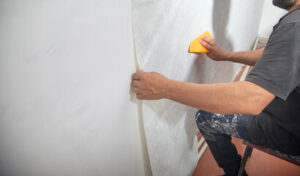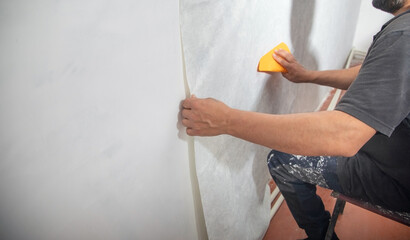Wallpaper can transform a room, adding style and flair to your home. However, installing wallcoverings requires skill and care to ensure a beautiful finished product.
Choosing the right installer for your project will help you avoid costly mistakes that can derail your design plans. Experienced wallpaper hangers prioritize accuracy to deliver impeccable results. Contact Nashville Wallpaper Installers for professional help.
Professional wallpaper installers use advanced techniques, knowledge, and expertise to deliver a flawless, visually stunning finish for your home. They prioritize customer satisfaction, communicate openly with clients, and make every effort to deliver quality workmanship. These factors translate to long-lasting results that look great and stand the test of time.
One of the most important steps in the wallpaper installation process is wall preparation. Professionals will thoroughly inspect and prepare the walls for application, addressing any cracks or imperfections that might impact the results. This will ensure that the wallpaper adheres properly and helps prevent any issues such as bubbles or wrinkles that can detract from your home’s aesthetic.
Depending on the type of wallpaper being used, there are different adhesives and primers that must be applied to ensure proper adhesion. Wallpaper professionals know the best products to use, ensuring that your new wallpaper will last for years. In addition, they are familiar with the latest trends and styles, helping you find the perfect wallpaper to complement your space.
Wallpaper contractors have experience working with a wide variety of wallpaper materials, including traditional, pre-pasted, and peel-and-stick. They also understand the nuances of applying different types of vinyl, fabric, and textured wallpapers. This knowledge helps them to anticipate any challenges that may arise during the project, preventing any costly mistakes and saving you time.
Mistakes during wallpaper installation can be extremely difficult to fix and can leave your space looking unfinished and sloppy. When you hire a professional, they will take the time to ensure that all details are taken care of, including matching patterns, precise cuts, and a seamless finish.
Homeowners who choose to undertake DIY wallpaper installations can end up with a lot of costly mistakes, such as visible seams, misaligned patterns, and bubbling or wrinkles. These mistakes can detract from your home’s beauty and lead to time-consuming, costly reinstallation. Professionals can provide you with a thorough quote that includes all aspects of the project, including material costs and labor expenses. This transparency helps you budget effectively and minimizes waste, resulting in savings on both your initial investment and future maintenance costs.
Proper Measurements
When installing wallpaper, accurate measurements are key. Mistakes can cause crooked lines and unsightly seams. In addition, using the wrong adhesive can also result in a less-than-stellar finish.
To avoid these issues, it’s important to measure accurately before starting the project. This includes measuring the height and width of the walls, taking into account any doors or windows. It’s also a good idea to consider any obstacles that may need to be accounted for, such as light switches or outlets. It’s essential to use a high-quality measuring tape and a sharp utility knife for precise cuts.
Once you’ve gathered the necessary tools, it’s time to start measuring for your wallpaper. To determine how many rolls you need, start by determining the square footage of the room’s walls. You can find this figure by adding the areas of all walls, then dividing that total by the coverage per roll (typically indicated on the wallpaper’s specifications or label). Be sure to add an extra 15% to your total wallpaper calculation to allow for trimming and pattern matching.
It’s also a good idea to take into account any windows, doors, or fixtures that you plan on covering with your wallpaper. This will help ensure that your framed wallpaper fits perfectly within the frame and doesn’t disturb your space.
If your wall has a slope, it’s best to level it before beginning the installation process. This will make it easier to cut straight, even lines and ensure a smooth, professional-looking finish.
To ensure that you have a straight, vertical line to reference while hanging your wallpaper, it’s helpful to use a plumb bob or another similar tool. A plumb bob is especially important for rooms with slanted ceilings, as it can help you avoid a crooked appearance.
Finally, it’s always a good idea to caulk baseboards and framing before applying wallpaper. This will make it much easier to reinstall these elements once the wallpaper is up, and it will also protect the trim from moisture and dust during the installation process.
Precise Cuts
When it comes to wallpaper, accurate measurements and precise cuts are essential for a smooth installation process and flawless results. Start by measuring the height and width of each wall you plan to cover, ensuring that your calculations account for any doors or windows. Next, draw plumb lines on the walls with a level to ensure they’re straight. Then, use these markings to measure and cut your wallpaper strips. Be sure to cut your pieces slightly longer to allow for trimming at the ceiling and baseboard. Using a utility knife or wallpaper scissors, make clean and precise cuts to avoid waste or uneven edges.
When working with patterned wallpaper, it’s important to match up the patterns as you cut them. To do this, lay your wallpaper flat on a cutting surface and use a straight edge and sharp utility knife to carefully cut along the marked lines. After each strip is cut, carefully roll it up with the pattern side inwards to prevent sticking and make handling the paper easier.
After cutting your wallpaper, it’s time to prep the walls. This includes sanding the walls to create a smooth and even surface, as well as cleaning any stains or mildew that may be present. Once the walls are clean and free of any imperfections, they should be sealed to help maintain a long-lasting and polished look.
Applying the adhesive is another crucial step in the wallpaper installation process. It is important to evenly distribute the adhesive over the backside of the wallpaper to ensure that the entire surface adheres properly. An uneven application can cause bubbles or wrinkles in the finished product, so it’s important to take your time and be thorough when working with wallpaper adhesive.
After applying the adhesive, it’s important to carefully smooth out the wallpaper with a wallpaper smoother or squeegee. This helps to create a perfectly seamless appearance and ensure that your wallpaper will last for years to come. To maintain a professional and consistent finish, it’s also helpful to keep a bucket of water and sponge nearby in case you need to quickly address any mishaps or creases during the installation process.
Long-Lasting Results
When you invest in professional wallpaper installation, you can rest assured your new wallpaper will stay in place for years to come. Professionals understand the right adhesives and primers to use for different types of wallpaper, ensuring a strong bond that prevents peeling or bubbling. They also know how to properly prep the walls before applying the wallpaper, minimizing the risk of damage or moisture problems later on.
Wallpaper can be tricky to hang properly, especially when dealing with complex or textured patterns. Those without professional training or experience may find themselves dealing with mismatched seams, crooked lines and other inconsistencies that will detract from the final aesthetic. Professionals are skilled at navigating difficult corners and seams, and they have the experience to handle even the most challenging materials.
In addition to installing high-quality wallpaper, professionals will help you explore the design possibilities and bring your vision to life. They will take the time to understand your design preferences, and they will be able to recommend wallpaper colors, styles and finishes that complement your space. They can even help you coordinate the wallpaper with existing pieces of art or furniture, enhancing the look of your home or office.
Another benefit of hiring a wallpaper installer is their access to wholesale pricing on materials. This allows them to save you money in the long run, as they can often get more discounts than retail customers and will be able to cut costs by purchasing large amounts of wallpaper at once.
Additionally, they will know which wallpapers require special care or installation techniques, such as those with a sheen that can reflect light in odd ways. They will also know which adhesives are best for different materials and how to handle issues such as humidity that can affect wallpaper installations.
If you are considering transforming your space with wallpaper, it is important to hire professionals that can provide quality results and excellent customer service. When searching for a wallpaper installer, make sure to read online reviews and testimonials, and ask for references from past clients.
